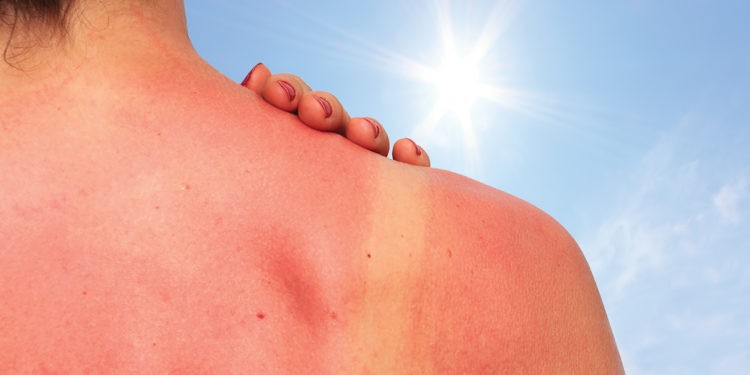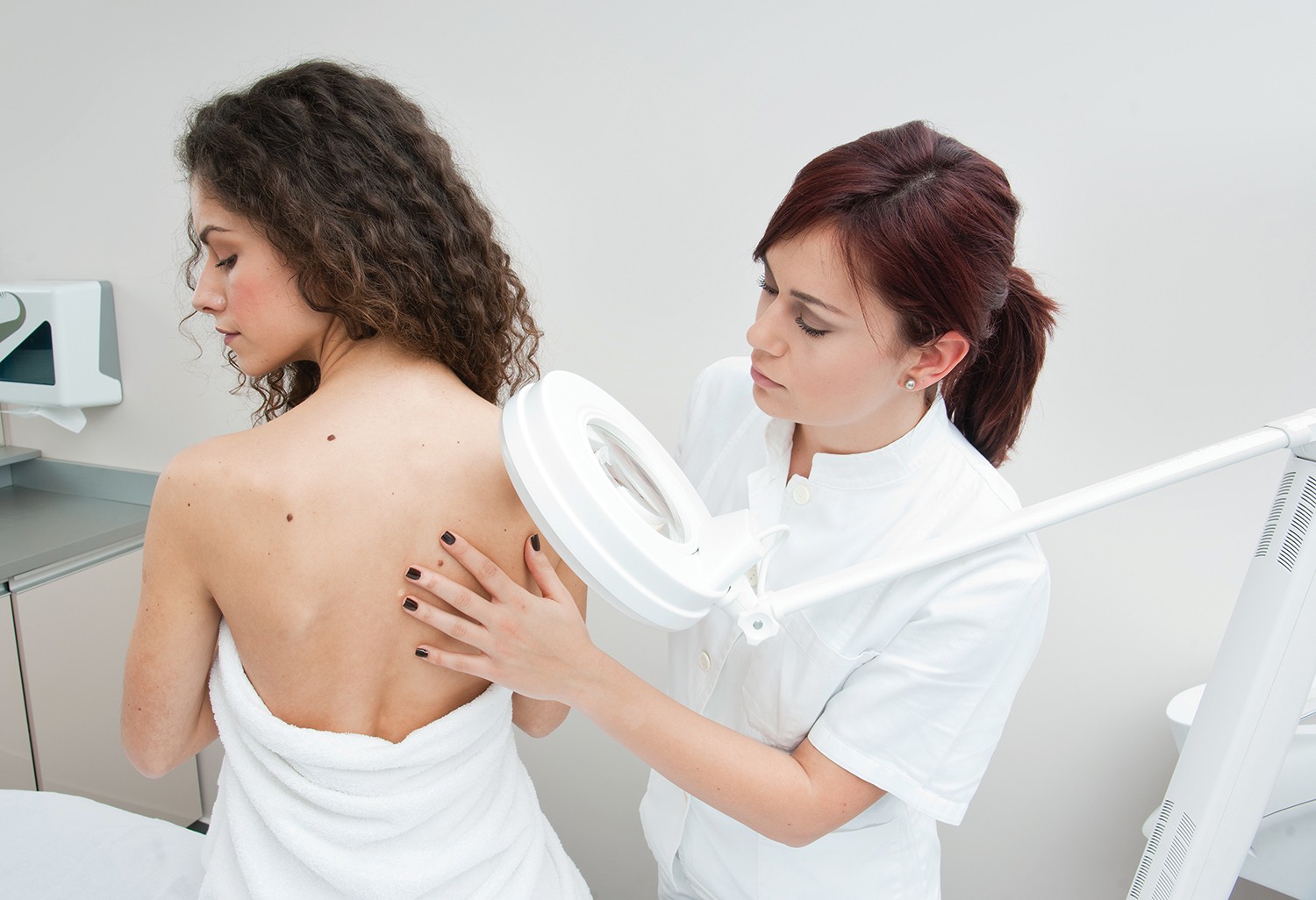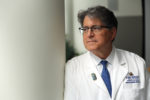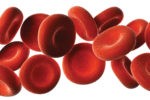Melanoma: The Most Common Form of Cancer

May is Melanoma/Skin Cancer Detection and Prevention Month
Photos courtesy of Dermatology and Skin Cancer Centers
Nobody likes to think about the possibility of cancer. When we do, it is usually because there is a reason, such as being personally exposed to the disease in some way or having been brought to mind through awareness campaigns. For the most part, however, we try to put the ugly, frightening reality of cancer far from our minds. It is a huge mistake, and we know that it is because when it comes to skin cancer, what we do not know about it — and ourselves, is killing us.
Let’s be clear. There is no “good” cancer and Healthy Kansas City magazine wants everyone to be as informed as possible about every form as even gaps in knowledge can cause a serious and dangerous misunderstanding. Breast cancer, for example, gets a lot of press and lung cancer may be the deadliest, but when it comes to the sheer number of cases, nothing comes close to skin cancer. One in five Americans will get some form of skin cancer in their lifetime, according to the Office of Disease Prevention and Health Promotion.

Skin cancer is by far the most common form of cancer, accounting for nearly half of all cancers in the USA. Each year nearly 3 million new cases are diagnosed. We spoke with Mark Fleischman, M.D., Medical Director at Dermatology and Skin Cancer Centers in Leawood, Kansas to get a better understanding of skin cancer detection and prevention.
Understanding the Enemy
Skin cancer occurs when the body does not repair damage to the DNA inside skin cells, allowing the cells to divide and grow uncontrollably. This damage may be caused by a variety of factors, including genetics and skin type. Most often, however, cases of skin cancer are caused by overexposure to ultraviolet (UV) light produced by the sun. Most people are aware of this, yet many misconceptions about skin cancer persist, according to Dr. Fleischman.

“The most common misconception I hear is the belief that darker skinned individuals or non-Caucasians are not at risk for skin cancer. The truth is skin cancer affects people of all skin color. While it is true that non-Hispanic Caucasians are more likely to develop melanoma and non-melanoma skin cancer than Hispanics and African Americans, the cancers they develop are diagnosed at a more advanced stage. This may be due to a delay in seeking diagnosis and treatment because of the misconception they are not at risk,” he explains.
Skin cancer may appear as a dark spot, lesion, a wound that does not heal or a bump on the skin. However, there is even misunderstanding about spotting skin cancer. Most skin cancers are non-melanoma, according to the Cancer Center, and if caught early, may be treated by a dermatologist in an outpatient procedure. Melanoma comprises about one percent of all skin cancers, but it is responsible for more than 90 percent of all skin cancer deaths. Many of these deaths are preventable with proper skin care and early detection.
Evaluations are Key to Good Health
What patients commonly believe about skin cancer can contribute to a delay in detection and intervention.
“Many patients are unaware that the majority of melanomas do not originate from an existing mole. In fact, approximately 70 percent of all melanomas arise from clinically normal appearing skin. The confusion is that these new melanomas can look nearly identical to a regular mole. That is why it is so important to monitor for any new or changing moles and have them evaluated by a board-certified dermatologist. Adding to the challenge of diagnosing melanomas, patients who have more than 50 moles on their body have an increased risk of developing melanoma. Essentially, the more moles you have, the higher your risk of developing melanoma,” Dr. Fleischman added.

The Need for Increased Awareness
Many incidents of skin cancer are preventable and treatable with early intervention. Yet, according to Dr. Fleischman, skin cancer rates are still rising, despite increased awareness.
“In 2019, it is estimated there will be more than 190,000 new cases of melanoma and 7,230 deaths related to melanoma. That is more than double the number of melanomas diagnosed 20 years ago. This trend is expected to continue upward until approximately 2030. It obviously takes time to change a society’s behavior to improve sun-protective behaviors and improve treatments, but I am hopeful we will see a decline in the number of skin cancers shortly after 2030.”
Advances in Detection
Fortunately, there have been many advances in the way we detect skin cancer with many additional in the works. Currently, there are several new and investigational devices and programs being tested for the detection of early melanoma.
“Apps for your phone, teledermatology, laser probes, DNA/RNA tape tests and even blood samples are all possible advances that may become mainstream and incorporated in daily dermatology practice; however, they are currently not the standard of care. These applications and devices will hopefully raise public awareness of skin cancer in the meantime and someday be incorporated into daily use in the dermatology clinics once they are more refined,” he continued.
The wisest course of action is to always have suspicious spots evaluated. “Currently, the best recommendation is to have any new or changing skin lesion evaluated by a board-certified dermatologist. If the lesion is clinically suspicious by visual assessment, then a minimally invasive surgical biopsy will be performed and the tissue sent to pathology for evaluation and diagnosis.”

Prevention Starts Now
The best prevention is reducing exposure to UV light all year, not just during hot, sunny, summer months. Protecting your skin from exposure daily, and not just on special occasions such as a day at the beach, is also important.
There are several ways to reduce your UV exposure, explains Dr. Fleischman.
“Physical blockers such as sun protective clothing is readily available at retail stores and online. These include wide-brimmed hats, long-sleeved shirts and pants. You should also seek shade, avoid the most direct rays of the sun during the hours of 10 a.m. through 2 p.m., and avoid tanning beds. Additionally, remember to apply a broad-spectrum sunscreen to any remaining exposed skin. Lastly, there is some early evidence that vitamin B3, also known as Nicotinamide at a dose of 500 mg twice a day, may help reduce some non-melanoma skin cancers by up to 23 percent in patients over age 30 who have had at least two or more non-melanoma skin cancers in the last five years.”

Solving the SPF Mystery
One of the best and simplest ways to prevent skin cancer is using a broad-spectrum water-resistant sunscreen, yet a majority of those who do use it, do so incorrectly.
“The most common question I get asked is what SPF is appropriate. I recommend using a broad-spectrum water-resistant sunscreen (blocks UVA and UVB) with at least an SPF 30, but I prefer my patients use one with an SPF 70 or higher and here is why. The recommended amount of sunscreen needed to obtain the full SPF benefit is about one ounce of sunscreen to cover the exposed skin while dressed in a T-shirt and shorts; however, most people only apply about 25 percent of the recommended amount of sunscreen in everyday use. So those whom apply only 25 percent of an SPF 30 sunscreen, are only receiving the benefit of about SPF 7 or 8, which is not nearly enough protection. In fact, we have a recent study that showed in everyday actual use, an SPF 100+ sunscreen was more effective in preventing sunburn than an SPF 50+ sunscreen, likely due to inadequate application.”
Evolving Treatments
Cancer treatments of all kinds continue to evolve, and this is true for skin cancer as well. One of the latest treatments showing promise is immunotherapy. Recently, experts at the Fred Hutchinson Cancer Center in Seattle, Washington, successfully treated a patient with metastatic melanoma by combining two types of immunotherapy for the first time. Outcomes continue to improve as doctors learn more and can better manage the side effects of these drugs.
Ongoing research, increased awareness, and improved prevention practices are all contributing to a better understanding that can result in better outcomes and reduced incidents of skin cancer in the future. What we do today makes a difference tomorrow.
For more information about Dr. Mark Fleischman, you can learn more at www.kcdermcenter.com, or to schedule an appointment, please call his office at (913) 451-7546.





